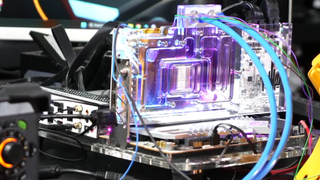World's first 'RTX 4090 Super' scores up to 16% higher than standard 4090 — Custom liquid cooled GPU has 3090 Ti PCB and faster GDDR6X
No Supes? No problem!

Yesterday, Brazilian tech channel TecLab showcased a custom-built GeForce RTX 4090 Super, utilizing liquid cooling along with the PCB and faster VRAM of a repurposed RTX 3090 Ti. Testing confirms that the beastly card can achieve performance up to 40% faster than the original RTX 4090, at least when testing Unigine Superposition at 8K. Considering the power of the original RTX 4090, managing performance gains of that caliber is quite impressive. While the stock RTX 4090 scored 12479 in Unigine Superposition at 8K, the fully-tweaked 4090 Super achieved 17454, or a 40% improvement. However, there is a caveat to these GPU numbers, which we'll address below.
RTX 4090 vs RTX 4090 Super Specifications
| Row 0 - Cell 0 | RTX 4090 Founders Edition Specs | RTX 4090 "Super" Specs |
| GPU Cores | 16384 Cuda Cores | 16384 Cuda Cores |
| GPU Memory Capacity | 24 GB GDDR6X | 24 GB GDDR6X |
| GPU Memory Speed | 21 Gigabits per second | 25.8 Gigabits per second |
| GPU Clock Speed | 2520 MHz | 3000 MHz |
| GPU Cooler | Hybrid Blower and Open-Air Cooler | Liquid Cooler Waterblock |
So, how can the RTX 4090 Super be 40% faster than the RTX 4090 if it's still mostly the same graphics card? Better cooling and much faster GPU core and VRAM frequencies still don't quite explain these performance gains. That's because they don't — the actual performance gains are closer to 16%.
The RTX 4090 Super's 8K Unigine Superposition result of 17454 was achieved with all its overclocking applied and driver LOD tweaks. Without driver LOD tweaks, the best the 4090 Super manages in 8K Superposition is 14537 compared to the original 4090's 12479, which is only a 16% performance improvement.
While impressive, why do the LOD tweaks inflate the results, and why should they even be considered? First, let's clarify what's involved with the LOD tweaks.
The LOD tweaks referred to in the coverage of this custom graphics card refer to the Nvidia GPU driver's management of LODs in 3D rendering. LOD stands for Level of Detail and refers to how various in-game models, effects, and textures increase or decrease in resolution based on proximity to the player. Those most determined to squeeze out extra performance in a game or a benchmark can apply driver-level LOD tweaks that make graphics worse and performance better, depending on severity.
This project would have been impressive, with or without the LOD tweaked benchmark. However, including it all seems misleading, particularly if you opt for 8K testing. A 16% faster RTX 4090 still makes for a wickedly fast graphics card, though, and that's still an impressive achievement. It's certainly more ambitious than creating a Noctua-themed version of the RTX 4090, though that project seems much more practical.
Stay On the Cutting Edge: Get the Tom's Hardware Newsletter
Get Tom's Hardware's best news and in-depth reviews, straight to your inbox.

Christopher Harper has been a successful freelance tech writer specializing in PC hardware and gaming since 2015, and ghostwrote for various B2B clients in High School before that. Outside of work, Christopher is best known to friends and rivals as an active competitive player in various eSports (particularly fighting games and arena shooters) and a purveyor of music ranging from Jimi Hendrix to Killer Mike to the Sonic Adventure 2 soundtrack.
-
mac_angel I'm confused. They got the PCB from a 3090ti and the VRAM was 25.8Gbs? The 3090ti came out with 21Gbs, the same as the 4090Reply -
Replymac_angel said:I'm confused. They got the PCB from a 3090ti and the VRAM was 25.8Gbs? The 3090ti came out with 21Gbs, the same as the 4090
No, they used the Galax HOF RTX 3090Ti's PCB, but replaced the board's 21 Gbps GDDR6X memory modules with RTX 4080 SUPER's memory modules rated for 24Gbps, although this GPU only supported 23 Gbps out of the box.
Then, they overclocked it to 26 Gbps. 4080 Super's binned 24 Gbps GDDR6X (ZF) modules were used.
So in the end, the modded "RTX 4090 SUPER" graphics card featured the AD102-300-A1 "Ada" GPU die, and had its memory replaced with binned 24 Gbps GDDR6X (ZF) modules. -
vinay2070 Reply
So they put a 4090 on a 3090Tis PCB. I didnt know the GPU pins were compatible across generations. Damn, whats intel even doing.Metal Messiah. said:No, they used the Galax HOF RTX 3090Ti's PCB, but replaced the board's 21 Gbps GDDR6X memory modules with RTX 4080 SUPER's memory modules rated for 24Gbps, although this GPU only supported 23 Gbps out of the box.
Then, they overclocked it to 26 Gbps. 4080 Super's binned 24 Gbps GDDR6X (ZF) modules were used.
So in the end, the modded "RTX 4090 SUPER" graphics card featured the AD102-300-A1 "Ada" GPU die, and had its memory replaced with binned 24 Gbps GDDR6X (ZF) modules. -
Replyvinay2070 said:So they put a 4090 on a 3090Tis PCB. I didnt know the GPU pins were compatible across generations. Damn, whats intel even doing.
Yes, GA102 is pin-compatible with AD102.
In fact, the RTX 3090 Ti card was used as a "Test vehicle", and as a learning curve by NVIDIA and its AIB partners, before the RTX 40 series came out.
And since Ampere "GA102" and Ada Lovelace "AD102" GPUs were likely pin-compatible, they could be featured on similar PCB designs, or ones with very little modifications. So AIBs weren't forced to design completely brand new boards either.
Most Popular








